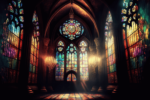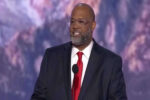In the sophisticated world of fine arts, classical musicians and professional artists are reaching their peers with the gospel.
At the John F. Kennedy Center for the Performing Arts in Washington, D.C., the orchestra is warming up for its performance tonight of Wolfgang Amadeus Mozart’s Requiem. The conductor, Patrick Kavanaugh, enters the concert hall and takes his place before the orchestra. He is dressed formally, in a black tuxedo, typical fashion for a modern conductor.
However, in a fashion hardly typical of a conductor readying himself to lead an orchestral performance, Kavanaugh bows his head and begins to pray aloud. When he finishes, spontaneous prayers erupt from all across the orchestra. The musicians too are praying for tonight’s performance.
“Bless all those who are present tonight,” petitions a violinist, “and open their hearts to the gospel message through the beauty and excellence of our performance.”
Soon the Kennedy Center Concert Hall will be filled to capacity with an audience eager to hear this evening’s concert by Kavanaugh’s orchestra–the Christian Performing Artists’ Fellowship (CPAF).
“We’re here to change a portion of society for Christ that no one else is touching,” says Kavanaugh, the founder and director of CPAF. “The performing arts world–the symphony, the opera, the ballet–is one of the most secularized portions of Western society.”
A Cultural Bridge
CPAF is one of three groups in the nation’s capital that share a common goal–to present the performing and visual arts in a way that will bring glory to God. For CPAF, as well as The Washington Arts Group and The Voice Behind, the arts are like a two-way bridge that may travel from the secular to the sacred or from the sacred to the secular.
They believe artistic expression can be a means for Christians to share a common creative passion with unbelievers and subsequently introduce them to Christ. Each of the three Washington-area groups, which are unaffiliated and work separately, expresses its own heartbeat for the arts differently. CPAF does so primarily through teaching the classical arts for the glory of God and spreading the gospel.
Its influence reaches well beyond Washington. CPAF is the largest nondenominational Christian ministry in the performing arts world today, with more than 1,000 members in almost every major orchestra in the United States.
Member chapters are in about 100 music schools as well. Participants in each chapter seek to establish local prayer groups, fellowship groups and musicians Bible studies.
Says Kavanaugh: “If you’re a classical musician and you’re a Christian, you know about us.”
In 1983, Kavanaugh and his wife, Barbara–a cellist–began praying with two other couples from the National Symphony in Washington. The six of them shared a common vision of becoming “musical missionaries.” They started giving classical, evangelical performances in local churches, and within two years, they had grown significantly in number and were showcasing performances at the Kennedy Center as well as Constitution Hall, Washington’s largest concert hall.
Today, more than a dozen CPAF performance groups, called Selah Ensembles, perform in the Washington area and other cities. The largest of the groups, the Asaph Ensemble–named after King David’s chief musician–combines orchestra, chorus and dance. CPAF performances are always free of charge and open to the public.
“When CPAF puts on a concert, it is an act of worship,” Kavanaugh stresses. “We’re not doing it to put our name in lights or to make money. We attempt to use our talents to reflect the beauty of the Lord.”
Kavanaugh admits it has been a long and difficult journey to credibility in the world of secular performing arts. “People look at us and think we’re just some Christian group–which translates into mediocrity in their minds,” he admits. “We have had to earn our audiences’ respect and the right to be heard through excellence.”
Each member of CPAF is dedicated to bringing his or her best to the Lord. Says Kavanaugh: “We treat every note, every line of the drama, every step of the ballet as a wonderful opportunity to please the Lord with our diligence.”
Kavanaugh has earned a high degree of respect for his knowledge in the field of music as well as his top-notch performances. He holds a doctorate in musical arts and has published seven books in the field, including The Spiritual Lives of the Great Composers (Zondervan). He is executive director of CPAF, composer and principal conductor of the Asaph Ensemble, and music director for King’s Chapel Fellowship–a charismatic church in Fairfax, Virginia.
“I can talk about Beethoven and Jesus in the same sentence,” Kavanaugh told Charisma, adding that blending the composer and the Christ into conversation isn’t as strange as it sounds.
“Great musicians and artists are generally aware of the spiritual world,” he notes. “They have a respect for things past, for authority and for discipline.”
CPAF is also a ministry to those in the performing arts world who have nowhere else to turn. “Many [classical musicians] have never been to a church–except for
a concert,” Kavanaugh says. “We often get calls from people who are hurting and don’t have a church or pastor to call. They know who we are, and they call for prayer. You might say we’re chaplains in the art world.”
Kavanaugh takes seriously Jesus’ call to go into the world and preach the gospel. “You can’t just tell them to come to church,” he says. “You have to get into their world, and sometimes that’s difficult. Christians think you’re nuts because you’re into this artsy stuff, and the artsy guys think you’re nuts because you talk about Jesus all the time. Sometimes you’re caught between two worlds.”
Kavanaugh is aware that a lot of bad things are happening in the arts today. He believes, however, that the church should seek its place within the artist community and not abandon it. He chides the church for not understanding the role of Christians in the secular arts.
“Too often, when a performing artist comes to Christ, the pastor pulls him aside and encourages him to get out of the ‘worldly’ arts and into the ‘Christian’ arena,” Kavanaugh says. “But what they’re doing is putting the salt back into the salt shaker. We’re trying to strengthen Christian artists so they can go into the secular world and be salt and light to those around them.”
Patrons of the Arts
Several other Christian ministries today are working to reclaim various segments of the arts community. The Washington Arts Group focuses on visual arts (see related article on the next page). Hundreds of professional actors and dancers find encouragement at Redeemer Church in New York City (see page 34). And at The Voice Behind, a Christian arts network also in Washington, members are busy transforming the culture.
Erik Lokkesmoe, founder and director of The Voice Behind, believes the church should be “leading the culture and pursuing excellence in all creative areas.”
“The church,” he adds, “was at one point the patron of the arts. It defined the culture through works of goodness, beauty and truth. But the church has lost its ability to communicate to the culture. We are talking to ourselves, and we are always a step behind.”
Lokkesmoe founded The Voice Behind in 2001 to work within the culture-shaping arenas of society to illuminate goodness, truth and beauty. The group takes its name from a passage in Isaiah that says whether you turn to the right or to the left there will be a voice behind saying, “‘This is the way; walk in it'” (Is. 30:21, NIV).
“We’re in a post-Christian world, and people no longer even understand what the Bible or being a Christian means. Our goal is to seed the culture for the gospel by creating things of beauty that reflect His glory.
“We want to share those saving moments in our world that lift us beyond the here and now to touch something so profoundly good, true and-or beautiful that it’s like running your fingertip along the floorboards of heaven,” Lokkesmoe says.
He believes all artists are attempting to discover truth and what it means to be human. “Artists are exploring a realm that is very spiritual,” he notes. “It may be very evil, but they’re trying to tap into the imagination and find something meaningful and excellent and even transcendent.”
The Voice Behind recently began a project called Brewing Culture. It is a monthly meeting of artists, patrons of the arts and any others committed to redeeming the culture who gather to talk about the role of art and artistic expression in faith. More than 95 people attended the first meeting in September at a restaurant near Washington.
Says Lokkesmoe: “Our dream is to have a Brewing Culture in every major creative city in the U.S.” Lokkesmoe also dreams of the day when churches will display art and sponsor nights to showcase talent among Christians. He believes the church should be pursuing the best ideas and the highest standards to produce what modern author and aesthetician Calvin Seerveld describes as the kind of “earthshaking drama where angels peer expectantly over the human shoulders to see what is coming out of the palette or typewriter.”
“While we are trying to speak into the culture, engage the culture and lead the culture, we also know any true redemption of the culture must come from a spiritual renewal,” Lokkesmoe says. “That’s why we need to encourage a new generation of artists in the church.”
Passing the Baton
Meanwhile, CPAF’s Kavanaugh is not content to limit his vision to adults. He also sponsors a top-notch performing arts camp where high school and college students are taught by world-class professionals in orchestra, chamber music, opera, piano, dance and theater. Add in a daily 7 a.m. prayer meeting, Bible studies tailored for performers and Sunday worship services in which George Frideric Handel’s Messiah is the hymnbook.
The monthlong camp, known as MasterWorks Festival, recently finished its seventh season of mentoring students in the performing arts, preparing them to be witnesses for Christ as they enter the secular performing arts scene.
The list of 75 teachers and guest artists who donate their time to MasterWorks reads like a who’s who of the performing arts world: Stephen Clapp, dean of the Juilliard School; John Nelson, conductor of the New York Philharmonic; Steve Rooks of the Martha Graham Dance Company; and Julietta Marcelli, veteran of Broadway.
Prayer and worship are keys to the success of the camp, held at Grace College in Winona Lakes, Indiana. “Sometimes during rehearsals tensions start to mount, and we just stop and take five minutes to pray,” Kavanaugh says.
“I look out over a sea of musicians raising their hands and praising the Lord, and the Holy Spirit comes down and solves the problem. That’s the way it ought to be, but this is the only place on the planet I’ve ever seen it happen.”
Hannah Schubkegel, 16, of Kalamazoo, Michigan, attended the camp for the first time this year. “It’s so cool to see a room full of musicians just laying their hearts out before God and asking for His will,” she says.
Kavanaugh says the kids also have to deal with another prevailing attitude in modern performing arts that says real musicians can’t be real Christians or that real Christians can’t be true musicians. Many students leave the camp with a new confidence and desire to share the gospel with fellow students on campus.
“I learned what it means to use music as a ministry–to seek, to serve and bless my audience,” one high school harpist from Reston, Virginia, told Charisma.
Bible study is a key practice at the camp and is encouraged at CPAF campus groups. Kavanaugh’s Bible study syllabus addresses issues high in the minds of his students. Topics include: “Being Faithful With Your Talent,” “Handling Criticism and Critics” and “Egomania vs. Humility.”
CPAF’s leaders also are working to expand the MasterWorks program to seven countries, and a MasterWorks Europe camp will be held near London in the summer. “This is one of the best ways to get the gospel out,” Kavanaugh says.
To Kavanaugh, as well as to Lokkesmoe and a growing number of Christians in the arts, reaching artists is a key to triggering spiritual revival.
Lokkesmoe, in fact, believes artistic people have more power than Washington politicians to transform culture.
“Politics is downstream from culture creation,” he says. “If you really want to bring about cultural renewal, then look to the artist.”
Jesus Came for Artists, Too
Artists in Washington put their faith on canvas and in stone.
Artists don’t always feel welcomed by the church–yet Christians who feel called to redeem the arts aren’t always warmly welcomed by their secular counterparts, either. That’s why Jerry Eisley started the Washington Arts Group 26 years ago–to support creative believers who don’t fit in the traditional religious mold.
Owner and director of the Foxhall Gallery in Washington, D.C., Eisley established the arts group in 1977 as a way to bring artists and patrons of the arts together. The organization sponsors artist discussion groups, cultural exchanges, exhibits, performances, workshops and multidiscipline conferences around the world.
Eisley often finds himself in spiritual conversations about art. At such times, he draws upon his wider background, which includes counseling and a master’s degree in New Testament literature and biblical studies. He’s a believer in the idea that art touches people spiritually above what the mind can comprehend. He saw it happen clearly in one patron, whom he says he will never forget, who purchased 25-30 pieces from his gallery.
Most of the paintings had been done by Christian artists, but none of them had a religious theme. They were simply landscapes and still lifes. Yet several months after the purchase, the collector came back to Eisley and told him the art she purchased from his gallery made her house feel like a cathedral.
“An art piece is able to satisfy and awaken a hunger in people for goodness, truth and beauty that transcends time and circumstance,” Eisley says.
Karen Swenholt, one of 50 artists whose works are showcased at the Foxhall Gallery, attempts to share the beauty of Christ through her sculptures.
“The best way I can minister to the world is to give them gifts of beauty,” she says. “Have you ever wondered why the Lord made so many flowers? I think it’s because of His generosity and His love. He decorated the world with beauty, and He’s using me as an artist to pour gifts of beauty on others.”
Swenholt sees art as a means of communicating spiritual reality to people who know nothing about Christianity.
“My [sculpture] pieces have kind of a surreal feel to them. That’s the art world’s lingo for vision,” she explains. “The art world believes that the subconscious is the place where you get truth, but God is the pure place where you get truth.”
Swenholt has produced some pieces with biblical themes, such as The Monumental Fool, The Hem of His Garment and End Game.
“Because I’m an artist people give me a certain respect and tolerance they might not give to others. I can do an anti-abortion piece such as End Game and get by with it. People will ask questions and listen while I share about the work. I try to be creative about the things of God, and I try to break through people’s preconceptions about Christianity.”
Swenholt, who believes God is awakening Christians in every creative field to reclaim the arts for Him, says: “The church has abandoned the arts, but I believe God is calling us to recover them for Him.”
The Arts Need a Redeemer
At Redeemer Church in New York, performers find support.
During a typical workday, Tom Jennings–director of worship and arts at Redeemer Presbyterian Church in New York City–might visit a local art studio, have lunch with a musician, lead a midday practice session or hang out with orchestra members backstage during rehearsal.
Jennings admits that his job is not that of your typical church “worship leader,” but then Redeemer is not your typical church. Since 1989 it has been a source of ministry involvement in the professional arts world. Some 400 professional musicians, dancers, actors and artists in the New York area attend Redeemer.
“Building relationships is my No. 1 job,” Jennings says. He believes evangelizing and discipling professional musicians and artists is just as important as preparing music for the Sunday morning service. It’s a belief born from his own involvement in professional arts.
His wife is an opera singer, and Jennings himself holds a Ph.D. in piano from Manhattan School of Music. He says he understands firsthand the challenges of being both a professional performing artist and a Christian.
“The church has alienated many artists by its negative approach to the arts and by its failure to strive for excellence,” he says. “It’s a real hindrance for a professional musician to sit through 45 minutes of screechy, out-of-tune music in order to hear a sermon that tells him his profession is what’s wrong with the world.”
At Redeemer most of the music and artistic leadership roles are held by those who have developed their gifts to the highest level through diligent study and extensive practical experience.
“There’s a common misconception among churches that it doesn’t really matter if you do something well as long as your heart is in it,” Jennings told Charisma. “But if your heart is in it, you’ll want to do it well.”
The typical church’s schedule in today’s society is another hindrance to reaching those in the performing arts world, Jennings believes. It is geared for people who have typical Monday-to-Friday jobs.
“Performers’ hours just don’t fit that schedule,” he argues. “Most [performing artists] work weekends and weeknights, and it’s difficult to feel a part of a church if you can’t attend its services and activities. ”
For this reason, Redeemer offers a Sunday evening service as well as weekly fellowship groups specifically for musicians, dancers, actors and artists–all seeking to help artists grow in their faith, build a sense of community and reach out with the gospel to their colleagues.
Kate Franco, a professional dancer, says the small fellowship group for dancers bolstered her faith.
“When I moved from Liverpool, England, to New York, the challenges I faced in trying to establish myself as a dancer started to pull me away from God,” she admits. “But Redeemer’s dance group pulled me back.”
Franco now leads the group, which was originally founded by three members of the Radio City Rockettes.
“When I first joined, these women showed me that I could excel as a dancer and also pursue my relationship with Christ,” Franco told Charisma. “There’s something wonderful about fellowshiping with people who really understand what you face and what you’re struggling to do artistically–and who are also committed to supporting you in your faith.”
Churches need to be more aware of artists in their midst, she believes. “Redeemer is leading the way, but I would like to see more and more churches accepting and encouraging performing artists.”
For information about the Christian Performing Artists’ Fellowship, visit www.christianperformingart.org; for The Washington Arts Group, www.washingtonartsgroup.org; for The Voice Behind, www.voicebehind.org.
Sandra K. Chambers is a freelance writer and high school teacher based in the
Washington, D.C., area. She loves classical music and has attended CPAF concerts.





Leave a Comment
You must be logged in to post a comment.